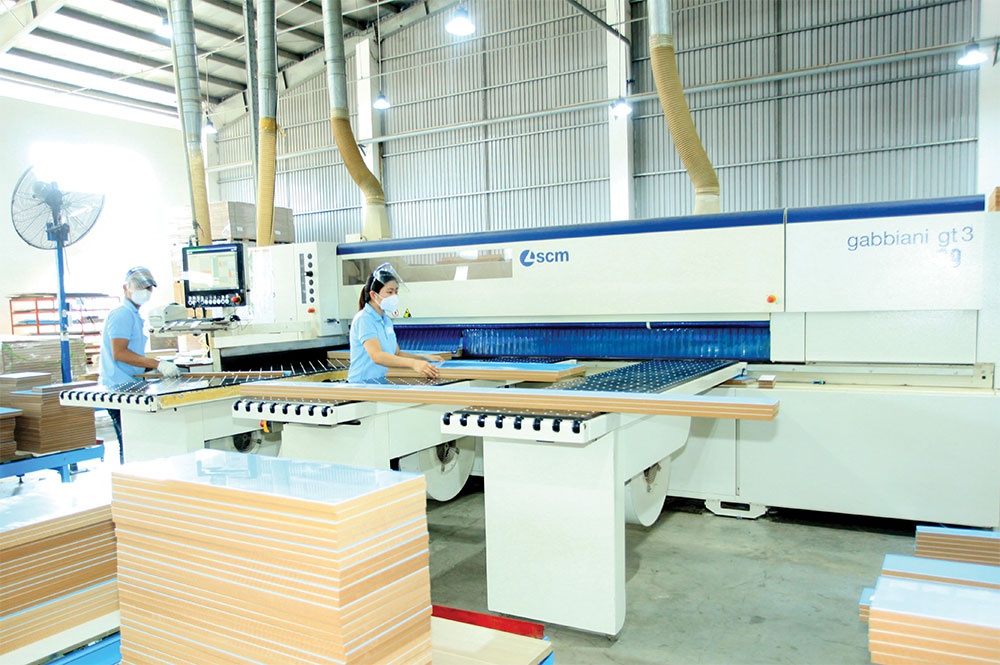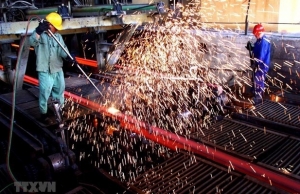Mechanical groups urged to diversify
 |
| Research and development is a key avenue for stronger global supply chain involvement, photo Le Toan |
Truong Thi Chi Binh, general secretary of the Vietnam Association of Supporting Industries (VASI), said there are many challenges for the mechanical industry, with a decline of 20 per cent in orders in the first eight months of 2023.
“This rate is up to 30-40 per cent for some manufacturers. However, the industry can still diversify due to the wave of change in the manufacturing sector globally,” Binh said.
Vietnam has a chance to increase activity in the US market, which could be worth more than $300 billion in 2030, she noted.
Vietnam exports machinery and equipment mainly to the US market, with the 2022 turnover estimated at more than $20 billion, up 12.5 per cent compared to 2021, accounting for more than 44 per cent of the country’s total machinery and equipment export turnover.
Nguyen Manh Hung, chief representative of the Vietnam Trade Promotion Office in New York, said, “The mechanical sector plays an important role in the US economy, especially in car manufacturing. The US will adopt advanced technology to produce electric vehicles as well as sustainable and eco-friendly products. There is ample room for Vietnam’s mechanical sector to boost exports to the US market.”
Hung encouraged local manufacturers to proactively source goods and comply with market regulations about product and safety requirements.
There are also positive signs of growing orders from Japanese partners. Ta Duc Minh, Vietnamese Trade Counselor in Japan, said the Japanese government is implementing a new policy of increasing imports from ASEAN to reduce the dependence on sourcing materials from China.
“Japan is a traditional market of Vietnam’s mechanical sector, accounting for 5 per cent of its total export turnover. Japanese firms tend to expand cooperation with Vietnamese mechanics as Japan is dealing with the challenges of an ageing population and difficult generation transfer,” Minh said.
“Therefore, Vietnamese mechanical companies should invest in research and development to participate in the global supply chain.”
Binh of the VASI further noted that the United Arab Emirates is considered a potential market for Vietnamese mechanical products as the mechanical sector only accounts for half of the UAE’s economic structure. The UAE focuses on crude oil exploitation and processing so it depends on imported machinery and equipment.
“While the sector looks to expand, domestic firms’ capability has shown significant improvement over the past few years. There are numerous phases of production in which Vietnamese firms can compete with Chinese and Indian enterprises. Vietnamese businesses need the support of Vietnamese trade offices overseas to improve market penetration and meet partners’ requirements,” Binh added.
The weakness of Vietnam’s mechanical sector lies in its dependence on raw material imports. MBT Electrical Equipment JSC is the only company in the entire country specialising in producing electrical transformers and electrical cabinets. However, there is a wide gap to put Vietnam on the global map of prestigious industrial electrical equipment manufacturers.
“The company’s profit remains low, which accounts for 5 per cent of the revenue due to the dependence on imported raw materials and selling through intermediaries,” said Tran Van Nam, general director of MBT Electrical Equipment JSC.
“The company is importing silicon steel, paper and insulating oil, copper foil and wires, as well as switches from Japan, Germany, Italy, and the US. The costs of materials make up half of the total costs. We are sourcing materials locally to ensure the target profit accounts for 20 per cent of revenue. However, the local materials do not meet quality requirements,” Nam added.
As of present, MBT has reached a capacity of 3,000 products, exceeding the level of 1,000 products in 2015.
Kim Hyo Tae, CEO of Doosan Vina, said at an industry conference in July, “The government should strengthen localisation policies to build the mechanical industry ecosystem and protect domestic companies. Many governments around the world have introduced supportive policies, in terms of taxes and infrastructure, to help companies increase their competitiveness in other countries.”
| In the development strategy for Vietnam’s mechanical industry, by 2035 the Vietnamese mechanical engineering industry will be developed with the most advanced technology, international-quality products, and further participation in the global value chain. The total output of the mechanical engineering industry will reach 40 per cent in the period up to 2030 and 45 per cent by 2035. |
| Nguyen Chi Sang - Vice president and general secretary, Vietnam Mechanical Association
In 2022, Vietnam’s total export of machinery and equipment is estimated at $45.8 billion, an increase of 19.45 per cent compared to 2021. This is the highest turnover in 10 years, nearly 15 times higher than in 2010. In particular, the export share of this item still belongs mainly to foreign-invested enterprises. Specifically, the export value of machinery and equipment of such enterprises is estimated at $42.58 billion, accounting for nearly 93 per cent and higher than the proportion of 92.75 per cent in 2021. Total demand for the domestic mechanical market by 2030 is estimated to reach about $300 billion. However, the mechanical sector only meets one-third of the demand. At present, mechanical companies are competing based on labour and production materials, which depend on imports. They have not yet mastered trade regulations in top export markets like the US. They also lack skills in finding customers. They are not only afraid to change production scale, but also have yet to identify traditional products. |
 | Mechanical engineering industry needs more incentives: PM Prime Minister Nguyen Xuan Phuc emphasized the need to facilitate the development of the mechanical engineering industry while addressing a conference in Hanoi on September 24. |
 | UKVFTA opens up opportunities for steel, mechanical firms Vietnamese exporters in the steel and mechanic sectors expect to get easier access to the UK market following the signing of the UK-Vietnam Free Trade Agreement (UKVFTA) last month. |
What the stars mean:
★ Poor ★ ★ Promising ★★★ Good ★★★★ Very good ★★★★★ Exceptional
Related Contents
Latest News
More News
- Takeda supports health resilience amid climate change challenges (December 18, 2025 | 12:39)
- Mondelez Kinh Do - a chapter of purpose-led leadership in Vietnam (December 18, 2025 | 09:44)
- VNPAY services receive the highest-level PCI DSS international security certificates for six consecutive years (December 17, 2025 | 23:47)
- PPL extends its reach into ASEAN (December 17, 2025 | 15:44)
- Over 600 BUV graduates meeting quality benchmarks across triple quality assurance levels (December 17, 2025 | 13:00)
- HEINEKEN Vietnam partners with Ho Chi Minh City Traffic Police on road safety drive (December 17, 2025 | 09:42)
- BUV and China’s CSCSE sign MoU to boost educational cooperation (December 17, 2025 | 08:00)
- PVT Logistics honoured with ‘Fast Enterprise Award’ at APEA 2025 (December 16, 2025 | 18:22)
- Empowering Sustainable Data Centers with Smart Infrastructure Solutions (December 16, 2025 | 13:59)
- Vietjet wins gold ESG transport sustainability award in Taiwan (China) (December 13, 2025 | 22:03)


 Tag:
Tag:






















 Mobile Version
Mobile Version